Alice Di Micele Keeps Going
Over a career spanning 35 years, singer-songwriter Alice Di Micele has released 17 albums while raising a family and maintaining a commitment to social activism. This year, she has driven across the country with her partner to perform in New England, New York, and Pennsylvania — her first gigs in the Northeast in 25 years.

Di Micele will perform at Pond Hill School (65 Old Paine Hollow Road, South Wellfleet) on Friday, April 4 at 7 p.m. It will be the first in a planned 16-show tour.
Currently based in Ashland, Ore., Di Micele grew up in New Jersey. “I started writing songs when I was a kid, even before I learned to play guitar,” she says.
While rooted in folk and Americana traditions, Di Micele’s music incorporates a wide range of genres — including jazz, soul, funk, and rock — which she performs with a voice that spans five octaves. Many of her songs are inspired by nature. “There’s a tune called ‘Celebrate the Rain,’ which I recorded for my first album,” she says. “I wrote it when I was 11 years old.” Another song, “Chinook Blues,” which appeared on her 1998 album Demons & Angels, explored the life cycle of the wild salmon in the Pacific Northwest and its declining population. Her latest album, Interpretations Vol. 1, was released in January 2024 and includes covers of songs by Neil Young, Christine McVie, Tom Petty, Sting, and the Grateful Dead.
For Di Micele, music is a way to strengthen and support community. Her audience in Wellfleet can expect Di Micele to lead a few singalongs as part of her concert. “This tour is my way of cruising around to try to give people some hope,” she says.
Tickets are $25. See alicedimicele.com for information. —Hazel Everett
The Revolutionary Music of Beethoven
Ludwig van Beethoven was notoriously moody. His personality is reflected by the instantly recognizable first four notes of his Symphony No. 5 — the dramatic and ominous motif evokes a feeling of profound agitation. The motif echoes through each section of the orchestra in the symphony’s first movement: quick and light in the upper strings and winds, dark and powerful in the brass. When it premiered in 1808, it was a bold departure from the more traditionally structured symphonies of the time. The composer was, without a doubt, a musical revolutionary.

At the Barnstable Performing Arts Center (744 West Main St., Hyannis) on Saturday, April 5 and Sunday, April 6, the Cape Symphony will perform an all-Beethoven concert. The program, titled “Beethoven: The Revolutionary,” will be conducted by Dina Gilbert and will include Beethoven’s “Leonore” Overture No. 3, his only violin concerto, and the Symphony No. 5.
Beethoven composed the “Leonore” overture in 1806. The short piece is the third overture Beethoven wrote for his opera Fidelio (originally called Leonore) before he was finally satisfied with his fourth attempt in 1814. The piece tells the story of a woman who disguises herself as a man named Fidelio in order to rescue her husband, Florestan, from imprisonment and death. The overture opens somberly, as Leonore believes her rescue mission is doomed. The music then builds in anticipation until, at the middle of the piece, a triumphant trumpet call signals Florestan’s liberation. From there, the music broadens into a romantic finale as the couple is reunited.

Beethoven’s singular violin concerto, also composed in 1806, will be performed by soloist Alexi Kenney. The piece is expansive — its first movement proud and virtuosic, its second movement serene, its third highly energetic. Culminating in Beethoven’s Symphony No. 5, the concert fully displays the revolutionary artistry of the composer.
Tickets are $16 to $75 plus fees, with discounts for students aged 6 to 22, at capesymphony.org. —Eve Samaha
Color and Composition
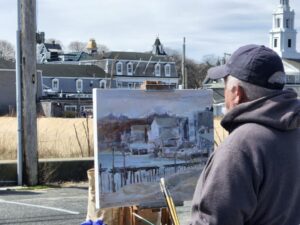
For the sixth and final workshop in the Creative Development Series this season at the Provincetown Commons (46 Bradford St.), Provincetown painters Jo Hay and Jim Broussard will teach fellow artists about color and composition in a hands-on class on Tuesday, April 8, at 5 p.m. The class will delve into color theory, the effects of building color on a canvas, and the interplay of color and composition, according to a course description.
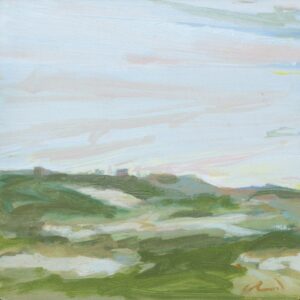
Broussard’s experience stems from decades of painting in the Outer Cape landscape. “Walks through the dunes of the National Seashore or Cape Cod’s seaside neighborhoods are my inspiration,” he says in a statement on the series website. His painting Shacks Late Afternoon situates the dune shacks on the horizon line, resting above the swoop of the dunes and floating just below skies streaked by puffy clouds.
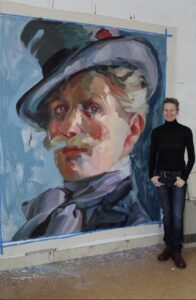
Primarily a studio painter, Hay is best known for “Persisters,” a series of large-scale portraits of contemporary women. “Painting with clean color mixes, I rely on accidents occurring to disturb the visual order,” she says. “If necessary, I will manufacture ‘accidents’ by adding a second or third color to my brush to make unpredictable color relationships that I feel have a life force of their own.” In her portrait of poet Amanda Gorman, yellows, oranges, pinks, and the subject’s red smile are rendered in a style both intentional and spontaneous.
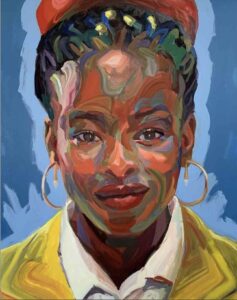
The workshop, which will be both in person and online in conjunction with the Community Development Partnership, is free, but registration is required. See provincetowncommons.org.
—Susan Rand Brown
A Fantasy Classic Comes to the Stage
The Lion, the Witch, and the Wardrobe is about magical worlds, talking animals, and epic battles. To create those elements for the stage, Cape Cod Theatre Company/Harwich Junior Theatre is turning to low-tech theatrical tricks rather than computerized wizardry.
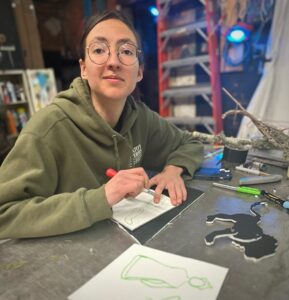
In the story, based on the 1950 novel by C.S. Lewis, the four Pevensie siblings — Peter, Susan, Edmund, and Lucy — enter the kingdom of Narnia through an enchanted wardrobe and become involved in an epic showdown between the evil White Witch and the lion-king hero Aslan. In this production, that climactic battle will be accomplished through shadow puppetry — a choice by director Anthony Teixeira that “adds to the chaos and magic of the moment because you can make puppets do things that humans can’t,” says set designer and puppet maker Calliope Pina Parker.
Other puppetry elements, wielded by backstage actors, will create backdrop scenery to enhance a simple, fabric-draped set illuminated by lighting designer Jeremy Bauldauf. Shadows of mountains and other structures can be moved closer to or farther from the characters on the stage to add perspective or movement, such as the illusion of walking toward a castle.
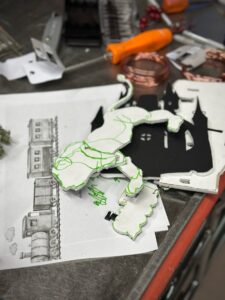
With shadow puppets, “there’s more chance for user error” than with the increasingly popular computerized projections used for theatrical scenery, says Parker. “You can’t time things exactly right,” she says. “But I’m drawn to the human element. It’s a lot like choreography.”
Creating the giant lion hero Aslan involves puppetry by three cast members, with a fourth providing an amplified voice from offstage. Costumer Claude Danner created Aslan’s head, and two people maneuver the character’s body in helmets attached to mattress topper foam, all hidden under structured fabric. Aslan’s legs connect to papier-mâché paws, and his tail is a fabric-covered garden hose.
The Lion, the Witch, and the Wardrobe opens on Friday, April 4 and runs through April 27 at 105 Division St., West Harwich. Tickets are $21 to 32 at capecodtheatrecompany.org. —Kathi Scrizzi Driscoll
Siân Robertson’s Artful Travels
While paper maps and atlases have become less common, they remain central to Siân Robertson’s art production. “They’re beautiful, and they have a history,” she says. An exhibition of Robertson’s work, “Detours & Diversions,” curated by Robert Rindler, is on view this month in the Great Pond Gallery at Wellfleet Adult Community Center (715 Old King’s Hwy.)
Robertson has been using maps in her artwork for more than 10 years. Most of them are given to her, but she buys some online. The locations and subjects of the maps vary, but those alone don’t interest her. It’s more the aesthetics and general appearance of a map that get her attention.
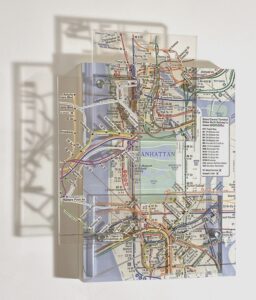
One of Robertson’s recent works incorporates a map of California vineyards, with a key that includes a small, bulbous wine glass. Another is made from a map of the New York City subway system. Robertson says that while she was drawn to the different colors and curves of each subway line, the map’s abstraction and the way its design prioritized practicality over reality also interested her. “Subways are translated into something that people can use to navigate, but the maps don’t really represent what’s going on underground,” she says. “They’re not a good representation in scale.”
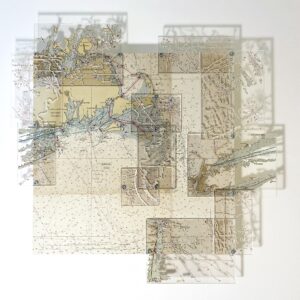
In another piece, a nautical map of Cape Cod includes a sailboat someone drew on it, adding the words “Ariel 1943.” Evidence of the personal history of the map’s previous owner — including coffee stains and smudges — also become part of the work. Robertson says she is fascinated by the mystery and questions posed by such elements. “Was ‘Ariel’ the name of their boat? Was it made in 1943?” she asks.
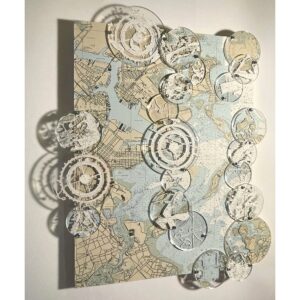
The format of her most recent works combines a central panel with layered acrylic pieces that extend over its edge. There’s a sculptural component to both the presentation and the process used to create it. Robertson uses an X-Acto knife to cut the maps, typically cutting away the spaces between streets, highways, and roads. The result can be as delicate as filigree. Shadows of the suspended pieces in each layer become part of the work.
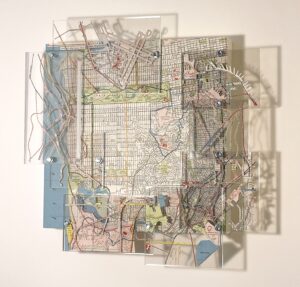
There will be an artist reception on Sunday, April 6 at 3 p.m., and the show is on view through the end of April. See wellfleetcoa.org for more information. —Chet Domitz



